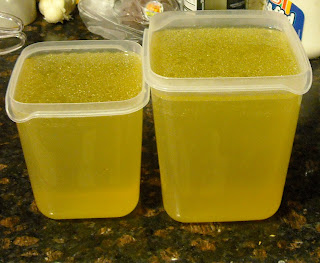Demi glace is like a secret weapon that hides in your sauces and takes them to a whole other level.
Demi glace is made from reduced brown veal stock. The stock can be used to make veloutes or gravies. Since I can't eat flour, an essential ingredient in veloute and gravy, I don't have much use for veal stock but demi glace is used to make reduction sauces and I have LOTS of uses for those.
Demi glace is a lot of work.
Demi glace made me cry. Mostly from frustration but finally from pleasure.
Once again, as with chicken broth or stock, the most frustrating part is having no way of knowing if/how your final product will turn out. I spent days slaving over this stuff and at the end, it tasted like nada. Well, not nada; it tasted like mildly beefy water. Not exactly what I was expecting. However, when I finally reduced what I thought was a demi glace (but was really still veal stock) down to a true demi glace and used it in a sauce, I was rewarded with a flavorful substance that defies description.
The trick to making demi glace is...there is no trick. And there is no recipe. Making veal stock and turning that into demi glace is just one of the important steps a chef takes in learning to trust her instincts. I did everything I was supposed to do but I didn't follow the directions to a T. This is SO important in cooking and I think it's why my instructor doesn't put a lot of stock (punny, I know) into recipes. YOU are going to eat this. Do YOU think it looks/smells/tastes right? When my bones didn't brown as quickly as the instructions said they would, I didn't take them out anyway and go to the step, I kept cooking them as long as it took to get them looking like I felt they should look. I can't stress enough how important it is to learn to trust yourself. In the end I did this and STILL thought I had a disaster on my hands but as you will see, my initial faith in my self paid off.
Ingredients:
- 6-7 lbs veal knuckle and marrow bones (It took me ages to find these. I went to many stores including butcher shops but I finally got them from Gelson's. You can probably find them cheaper from Harvey's Guss)
- 2 lbs mirepoix, roughly chopped into large, comparably sized pieces (onion, leek greens, celery, carrots)
- 1 cup red wine
- bouquet garni (garlic clove, thyme, chives, parsley, peppercorns, white leek leaf, bay leaf)
Roast 30 minutes then turn the bones. Continue to roast until bones are brown, 1 to 3 hours. (took me 2 plus.)
Add mirepoix to the pan, leaving out the leeks (if they roast too long, they will burn) and roast another 30-60 minutes.


When the veggies are just starting to caramelize, add the leeks and continue to roast until the mirepoix vegetables are nicely caramelized (took me almost 2 hours, total.)
Place the bones and mirepoix in a LARGE stock pot then deglaze the roasting pan with a cup of decent red wine and a wooden spoon.
Pour the resulting liquid into the stock pot. Fill the stock pot with cool water until the level is a few inches above the bones. (Mine was about 2-3 inches, I ended up with A LOT of stock, too much water, I think. Next time I would just cover the bones.)
Simmer at a "tremble" (French = "fremir") for 6-8 hours. Periodically skim off any scum that floats to the top.
Bring down to room temperature then refrigerate overnight. (If you need to bring down the temp fast, divide the stock into smaller containers)
Skim off the fat that collects on top.
Now you have veal stock!
Let's make demi glace:
Reheat. Bring to a slow simmer and continue simmering slowly to reduce stock by AT LEAST 50% (up to 90%.)
The consistency should noticeably thicken and the demi glace should have a nice aroma and mild but meaty taste*. Freeze for up to 3 months.
*My stock was oily, tasted (as I said) like beef water and was not thick but was slightly gelatinous. I declared it a failure and cried and cursed the heavens for allowing me to abuse that poor cow-baby's bones in such a fruitless manner. I froze it anyway and pulled some out of the fridge a few weeks later. To my shock, with a bit more reducing, I was able to make an OUT OF THIS WORLD red wine reduction sauce. The moral is, don't give up on your demi glace. When in doubt, reduce, reduce, reduce. You might be surprised at how it turns out!























